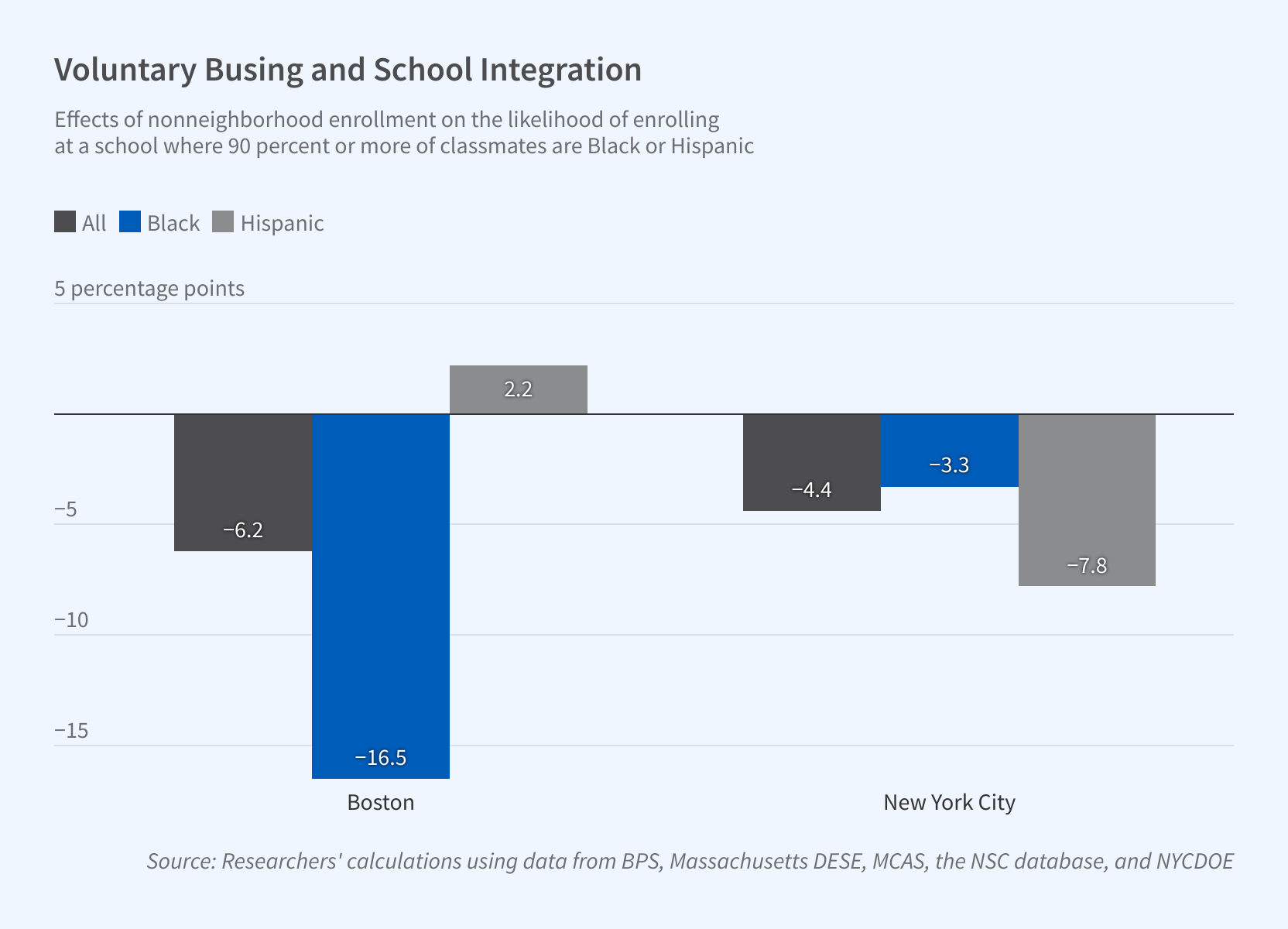Nonneighborhood enrollment in New York and Boston boosts integration but has little effect on scholastic achievement or college attendance.
In the 1970s, court orders to integrate schools led many US cities to bus students far from home. Though court-mandated busing has disappeared, many urban districts now have voluntary school choice programs that allow students to attend schools outside of their neighborhoods when space permits. In many of these systems, students are assigned to seats using school-matching algorithms that take account of applicant preferences and school priorities, randomizing seats when schools are oversubscribed. Choice systems aim to decouple school assignment from residential segregation, and ideally increase both integration and student achievement. At the same time, school transportation in large urban districts is increasingly expensive, so districts face a trade-off.
In Still Worth the Trip? School Busing Effects in Boston and New York (NBER Working Paper 30308) Joshua Angrist, Guthrie Gray-Lobe, Clémence Idoux, and Parag Pathak ask whether school choice programs in Boston and New York City boost integration and learning, especially for minority students. They find that school choice helps integrate schools. About 40 percent of the students in their sample attend schools in which their peers were more than 90 percent Black or Hispanic, a measure of "minority isolation."  Nonneighborhood school enrollment decreases the probability of attending a minority-isolated school. In Boston, nonneighborhood school attendance reduces the probability that a Black student attends a minority-isolated school by 17 percentage points. Among Black New York applicants, nonneighborhood enrollment results in a roughly 9 percentage point reduction in the share of Black peers and a 5 point increase in Hispanic peers. Effects on minority isolation in New York are smaller.
Despite the gains in integration, attending more-integrated schools is not associated with better achievement as measured by standardized tests or college attendance. Test scores for Boston and New York students who attend nonneighborhood schools are not significantly different from those of students who attend neighborhood schools. Results are similar when school travel is measured in terms of commute time. An extra 20 minutes of travel does not increase the likelihood of college attendance, and may even decrease it for Black students in Boston and Hispanic students in New York.
Data on Boston students cover all applicants for 6th and 9th grade seats in the centralized middle and high school matches for the school years beginning in 2002 through 2013. Test scores from the Massachusetts Comprehensive Assessment System, a standardized exam taken by all public school students in the state, are used to measure achievement using baseline scores from 4th and 7th to 8th grades for middle and high school student applicants, respectively. For New York, data are available on applicants to 9th grade public high school programs from fall 2012 to fall 2016. SAT scores on tests taken in 11th grade are used as achievement measures.
In Boston, the centralized match excludes students who attended publicly funded charter schools and one of three public, selective-enrollment exam schools. In New York, the centralized school match sample excludes charter schools and specialized exam high schools. In both cities, demographic controls include race, subsidized lunch status, sex, special education status, and language proficiency.
In general, those applying to attend schools outside of their neighborhoods have demographic characteristics broadly similar to those of students attending neighborhood schools. Applicants for districtwide choice have lower baseline test scores than average, in part because the samples exclude students applying only to charter and highly selective schools.
The researchers compare the observed outcomes with a counterfactual setting in which all students attend neighborhood schools. In this scenario, minority isolation rises by 10 percentage points for Black Boston students and by 4 percentage points for Black New York students. Hispanic students are estimated to see minimal changes in minority isolation or same-race exposure under neighborhood assignment. These changes would be accompanied by travel time reductions of about 13 minutes for Black Boston middle- and high-schoolers and 17 minutes for Black New York high-schoolers, and by reduced outlays on transportation, which they estimate at roughly $1,000 per transported student in Boston and $1,300 in New York City. — Linda Gorman
|

No comments:
Post a Comment